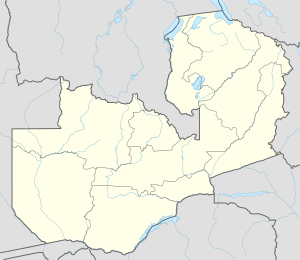Chirundu Bridge
Coordinates: 16 ° 2 ′ 16 ″ S , 28 ° 51 ′ 7 ″ E
| Otto Beit Bridge | ||
|---|---|---|
| Crossing of | Zambezi | |
| place | Chirundu , Zambia / Zimbabwe | |
| construction | Suspension bridge | |
| overall length | 369 m | |
| Longest span | 328 m | |
| completion | May 24, 1939 | |
| planner | Sir Douglas & Francis Fox | |
| location | ||
|
|
||
Chirundu Bridge is the common name for two side-by-side road bridges across the Zambezi between the towns of the same name Chirundu on the north bank in Zambia and Chirundu on the south bank in Zimbabwe . Chirundu Bridge is one of only five road bridges over the Zambezi. It is the most important part of the road link between Lusaka and Harare , the capitals of the two states.
Otto Beit Bridge
The Otto Beit Bridge is a two-lane suspension bridge with a length of 382 m and a span of 320 m.
Their pylons consist of concrete pillars that extend to the deck girder. The superstructure of the pylons is formed on these pillars by vertical, narrow lattice girders, which are connected and stiffened by several diagonal steel girders. The suspension ropes consist of parallel wire ropes , which were bundled in strands of 37 wires each before assembly and pulled onto the pylons as such and then formed into suspension ropes using rope presses. This saved the costly air-jet spinning process and the travel of the necessary specialists. The suspension ropes only support the bridge deck between the pylons, which is stiffened by light, but relatively high lattice girders. The short space between the pylons and the high banks is bridged by simple half-timbered ramps that rest on the pylons and at the ends of the bridge.
The Otto Beit Bridge was one of four road bridges (and a railway bridge) commissioned by the Beit Trust of the German-British-South African gold and diamond magnate Alfred Beit, who died in 1906 , to establish road connections in what was then Rhodesia and southern Africa in general. The bridge is named after Alfred Beit's brother Otto.
The consulting engineers Sir Douglas & Francis Fox , London, were commissioned with the planning of the bridge and the corresponding road connection. At that time they were working as planning and construction management engineers for almost all railways in southern Africa. In the engineering office, Ralph Freeman was responsible for the bridge, who had already been involved in the planning of the Sydney Harbor Bridge and had led the planning of the Birchenough Bridge . The bridge was built by the English steel construction company Cleveland Bridge & Engineering Co. The opening ceremony took place on May 24, 1939 in the presence of Lillian Beit, Otto Beit's widow, and the British governors of North and South Rhodesia.
The originally two-lane bridge can only be used in one lane by modern trucks and was no longer able to cope with the increased traffic loads. After the opening of the new Chirundu Bridge, it was therefore not used and repaired. Since 2010 it has been in use again for passenger traffic to the north.
Chirundu Bridge (2003)
The second Chirundu Bridge is 90 m above the Otto Beit Bridge. It is a 400 m long two-lane reinforced concrete - concrete box bridge, the bridge three fields are supported by two concrete pillars in the current (whose waters now from Kariba Dam tamed). It was in the years 1999 to 2003 by the Japanese company Kajima Corporation , with the support of the Japanese Foreign Ministry - built (Ministry of Foreign Affairs of Japan MOFA). Since 2010 it has been used for all traffic to the south as well as for truck traffic to the north.
Individual evidence
- ↑ Hyder Consulting: Footprints on a global landscape - 150 years of improving the built environment ( Memento of November 24, 2013 in the Internet Archive ) (PDF; 4.3 MB)
- ↑ A Bridge too far ...? on Memories of Rhodesia
- ^ The Chirundu Bridge Construction Project on the MOFA website

